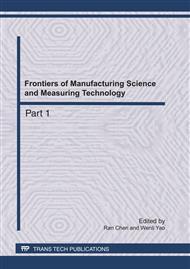[1]
I. F. Akyildiz, and W. L. Su: A survey on sensor networks, EEE Communications Magazine. Vol. 40(2002), pp.2-116.
Google Scholar
[2]
W. f. Liang, and Y.Z. Liu: Online data gathering for maximizing network lifetime in sensor networks, IEEE Trans. on Moblie Computing. Vol. 6(2007), pp.2-11.
DOI: 10.1109/tmc.2007.250667
Google Scholar
[3]
X.Y. Wu, and C.G. Cassandras: A maximum time optimal control approach to routing in sensor networks, Proceedings of the 44th IEEE Conference on Decision and Control, and the European Control Conference 2005 Seville. Spain: IEEE Computer Press(2005).
DOI: 10.1109/cdc.2005.1582311
Google Scholar
[4]
H. Tan, and I. Korpeoglu: Power efficient data gathering and aggregation in wireless sensor networks, SIGMD Record. Vol. 32(2003), pp.66-71.
DOI: 10.1145/959060.959072
Google Scholar
[5]
Y.H. Zhu, W.D. Wu, V.C. M. Leung, and L.H. Yang: Energy-efficient tree-based message ferrying routing schemes for wireless sensor networks, ChinaCom 2008. Hangzhou, Zhejiang, China(2008), pp.25-28.
DOI: 10.1109/chinacom.2008.4685156
Google Scholar
[6]
Y.H. Zhu, D.D. Shen, W.D. Wu, Z.W. Shen, and Y. P Tang: Dynamic routing algorithms optimizing lifetime of wireless sensor network, Acta Electronica Sinica, Vol. 37(2009), pp.1041-1045.
Google Scholar
[7]
N. Xu and C.G. Cassandras: On maximum lifetime routing in wireless sensor networks, Joint 48th IEEE Conference on Decision and Control and 28th Chinese Control Conference, Shanghai, P.R. China, IEEE Computer Press(2009), pp.3757-3762.
DOI: 10.1109/cdc.2009.5400394
Google Scholar
[8]
Y.H. Zhu, C.X. Yang, W. D. Wu and Y. P. Tang: Diffluent traffic routing algorithms trading off net work lifetime and number of packet hops for wireless sensor net works, Chinese Journal of Sensors and Actuators, Vol. 22(2009), pp.273-279.
Google Scholar
[9]
J.H. Holland: Adaptation in natural and artificial systems: an introductory analysis with applications to biology, vontrol, and artificial intelligence, the MIT Press(1992), pp.1-228.
DOI: 10.7551/mitpress/1090.001.0001
Google Scholar


